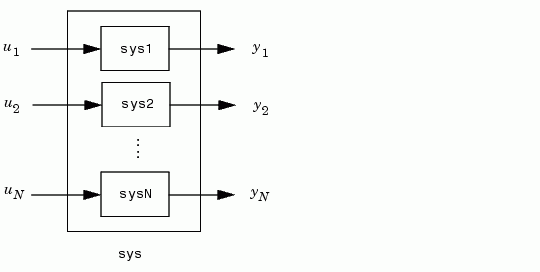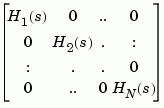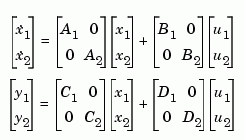

| Function Reference |   |
Group LTI models by appending their inputs and outputs
Syntax
Description
append
appends the inputs and outputs of the LTI models sys1,...,sysN to form the augmented model sys depicted below.

For systems with transfer functions  ,...,
,..., , the resulting system
, the resulting system sys has the block-diagonal transfer function

For state-space models sys1 and sys2 with data  and
and  ,
, append(sys1,sys2) produces the following state-space model.

Arguments
The input arguments sys1,..., sysN can be LTI models of any type. Regular matrices are also accepted as a representation of static gains, but there should be at least one LTI object in the input list. The LTI models should be either all continuous, or all discrete with the same sample time. When appending models of different types, the resulting type is determined by the precedence rules (see Precedence Rules for details).
There is no limitation on the number of inputs.
Example
c = x1 x2 y1 1.00000 0 y2 0 0 y3 0 3.00000 d = u1 u2 u3 y1 0 0 0 y2 0 10.00000 0 y3 0 0 4.00000 Continuous-time system.
See Also
connect Modeling of block diagram interconnections
feedback Feedback connection
parallel Parallel connection
series Series connection
 | allmargin | augstate |  |